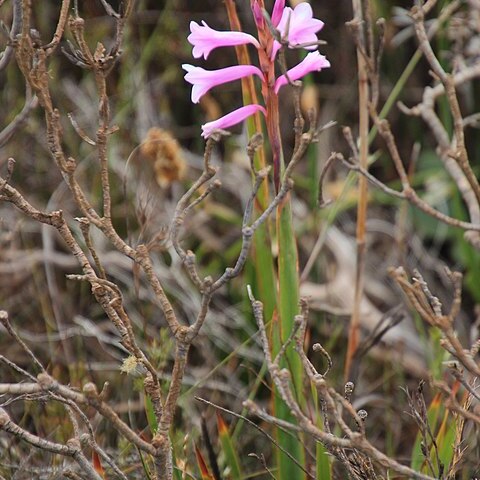Plants 200-500(-650) mm high. Corm subglobose, 20-30 mm diam.; tunics coarsely netted. Stem erect, simple or with up to 3 short, ascending branches. Leaves 4 to 6, mostly ± basal with uppermost partly or entirely sheathing stem below, 1/3-2/3 as long as spike, lanceolate to linear, (3-)6-20(-28) wide, often glossy, midrib and margins lightly to strongly thickened and hyaline; bract-like cauline leaves 1 or more. Spike usually 8-to 20-flowered; bracts usually overlapping, broadly clasping below, green below but dry and pale brown distally with evident netted venation, becoming dry throughout and lacerate, 10-20 mm long, inner ± as long, minutely forked apically. Flowers zygomorphic, pale pink to purple or orange, rarely white; perianth tube funnel-shaped, lower part 10-15 mm long, emerging ± 5 mm from bracts, upper part flaring slightly or rarely ± subcylindric and horizontal or slightly pendent, 7-15(-25) mm long, ± 6 mm diam. at mouth, usually with well-developed longitudinal ridges between filament bases; tepals spreading, obovate to oblanceolate, 14-16 x ± 8 mm. Filaments unilateral and declinate, 8-15(-25) mm long; anthers 4-5 mm long, yellow (rarely purple). Style arching below stamens, dividing near apex of anthers, branches ± 3 mm long. Capsules fusiform, 15-20 x ± 4 mm long, dehiscing only above. Seeds linear, 5-8 x 1.0-1.3 mm, 1-or 2-winged.
More
Perennial herb, geophyte, 0.2-0.5 m high; corm ± globose, tunics grey-brown, coarsely reticulate; stem usually simple. Leaves ensiform, margins and midvein lightly thickened. Bracts green below, dry and brownish in upper half, lacerate after flowering. Inflorescence a spike; flowers pale pink to purple, orange or white; perianth tube 18-22 mm long, flared above; tepals obovate to oblanceolate, acuminate. Stamens unilateral, declinate; filaments up to 18 mm long; anthers 4 mm long, facing upper tepal, sometimes contiguous, yellow. Ovary oblong. Flowering time Sept.-Nov. Capsule fusiform.
Dwarf cormous geophyte, 30-40 cm. Leaves sword-shaped. Flowers pink to orange or white, sometimes with pink keels, stamens declinate.

